NVIDIA GeForce GTX 670 Review Feat. EVGA: Bringing GK104 Down To $400
by Ryan Smith on May 10, 2012 9:00 AM ESTAs always, we’re wrapping up our look at a video card’s stock performance with a look at power, temperature, and noise. As GTX 670 is a lower clocked, lower power, harvested version of GK104, it should do even better than GTX 680 here. Remember, the power target for GTX 670 is only 141W.
| GeForce GTX 600 Series Voltages | |||||
| Ref GTX 670 Boost Load | EVGA GTX 670SC Boost Load | Ref GTX 680 Boost Load | Ref GTX 670 Idle | ||
| 1.175v | 1.162v | 1.175v | 0.987v | ||
Stopping to take a quick look at voltages, we find that NVIDIA hasn’t really adjusted the voltages of GTX 670 compared to GTX 680. Because GTX 670 has a lower maximum boost bin than GTX 680 it ramps up to 1.175v a bit sooner, but otherwise it’s still covering the same range of voltages as opposed to having a lower max voltage to further improve the power consumption. EVGA however does just that, topping out at 1.162v. They’ll need all the power savings they can get since power consumption is inversely proportional to performance under NVIDIA’s power target system.
On that note before we jump into our graphs we wanted to try something new: a look at the average core clockspeed during our benchmarks. Because of GPU boost the boost clock alone doesn’t give us the whole picture – particularly when also taking a look at factory overclocked cards – we’ve recorded the clockspeed of our GPU during each of our benchmarks when running them at 2560x1600 and computed the average clockspeed over the duration of the benchmark.
| GeForce GTX 670 Average Clockspeeds | ||||
| GTX 670 | EVGA GTX 670SC | |||
| Max Boost Clock | 1084MHz | 1188MHz | ||
| Crysis | 1057MHz | 1079MHz | ||
| Metro | 1042MHz | 1066MHz | ||
| DiRT 3 | 1037MHz | 1062MHz | ||
| Shogun 2 | 1064MHz | 1105MHz | ||
| Batman | 1042MHz | 1075 MHz | ||
| Portal 2 | 988MHz | 1034MHz | ||
| Battlefield 3 | 1055MHz | 1080MHz | ||
| Starcraft II | 1084MHz | 1129MHz | ||
| Skyrim | 1084MHz | 1113MHz | ||
| Civilization V | 1038MHz | 1073MHz | ||
| OCCT | 953MHz | 980MHz | ||
In spite of the GTX 670’s boost clock of only 980MHz, we see that it spends almost its entire time above that, and indeed spends its whole time above the base clock. As far as games go, with the exception of Portal 2 it’s always in the mid-1000s, whereas the GTX 680 was only a bit higher at the high 1000s. This is a big part of why the GTX 670 has performed so well in our tests: it may be rated lower, but in fact it can reach clockspeeds very close to the GTX 680.
At the same time this is why we see the EVGA GTX 670 Superclocked struggle to separate itself from the reference GTX 670, in spite of a 6%+ factory overclock. Too much of the time it’s simply not boosting much higher than the reference GTX 670, which limits the performance gains. With GPU Boost in effect this means there are a range of cards and we could be looking at a particularly good reference GTX 680, but whether that’s the case or not the end result is that EVGA’s card can’t do too much amidst the 141W power target limit.
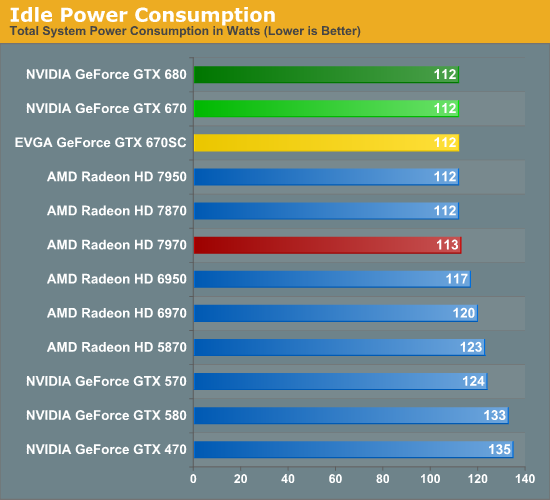
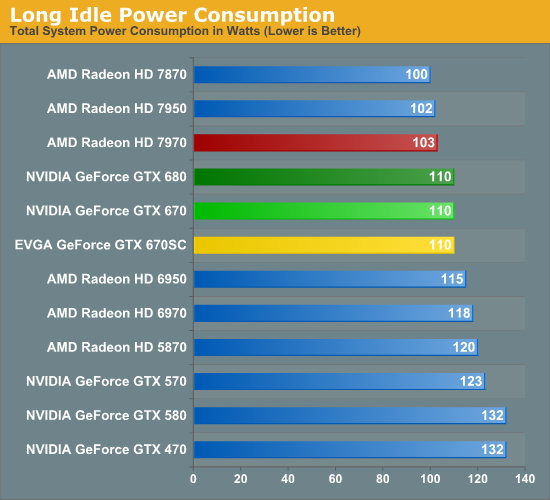
Starting with idle power, there aren’t any major surprised compared to the GTX 680. NVIDIA and AMD have both done such a good job managing their idle power consumption that even with the disabled SMX there’s no measurable difference between video cards. GTX 680 and GTX 670 effectively have the same idle and long idle power consumption.
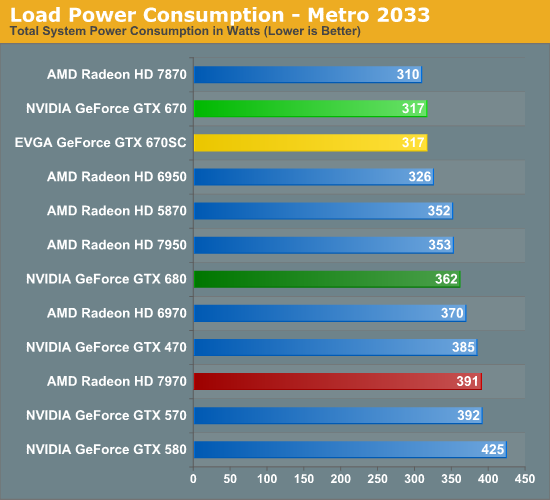
Moving on to load power consumption we can immediately see the GTX 670’s lower power target come into play. At 317W from the wall it’s 45W less than the GTX 680 for roughly 90% of the gaming performance, and this is in fact is lower power consumption than anything except the Radeon HD 7870. Even the GTX 560 Ti (which isn’t in this chart) is higher at 333W, reflecting the fact that GK104 is the true successor to GF114, and which would make GTX 670 the successor to GTX 560 from a design perspective.
Of course this also means that GTX 670 does very well for itself compared to AMD’s cards. We saw GTX 670 slightly outperform 7950 in Metro and here we see it drawing 36W less at the wall at the same time. Or compared to the 7970, 7970 can outperform GTX 670 by about 10%, but we’re drawing 74W more at the wall as a result.
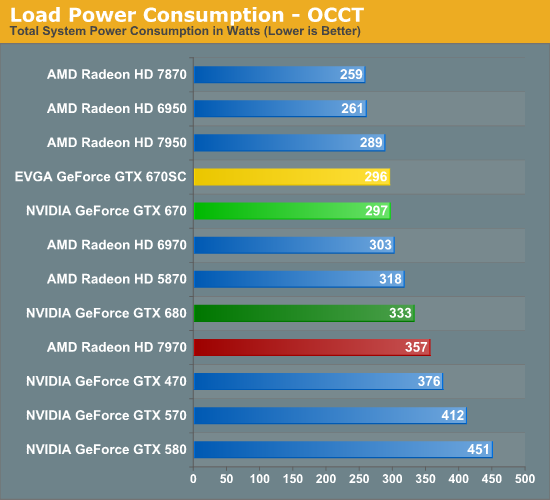
Relative power consumption shifts slightly under OCCT, but the story is otherwise similar. It’s not immediately clear why GTX 670’s power consumption is slightly higher than 7950 even after what we saw with Metro (PowerTune should be capping at 200W), but at least in this test the GTX 670 does end up doing a bit worse. On the other hand it’s still 60W less than the 7970.
Otherwise if we compare the GTX 670 to the GTX 680 we see that the GTX 680 ends up drawing 36W more at the wall, only a bit less than the difference we saw under Metro and quite close to what we’d expect based on the cards’ specifications.
On a related note, pay close attention to NVIDIA’s power target system in action here. In spite of the fact that the GTX 670SC is a binned part running at a lower voltage and higher clockspeeds, it’s drawing 1W less than the reference GTX 670. It would appear that NVIDIA has very good control over their power consumption overall, even if they can only adjust clocks for it a few times per second.
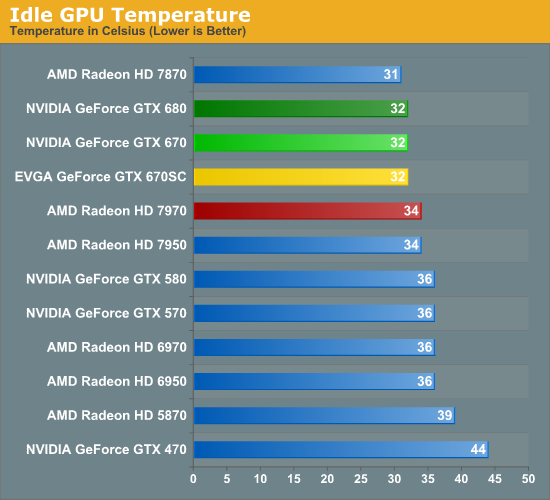
Seeing as how NVIDIA is using roughly the same cooler design with GTX 670 as they are with GTX 680 and they have the same idle power consumption, it should come as no surprise that temperatures are so similar. 32C is among the lowest of the temperatures we’ll see for a blower unless it’s running fast & loud.
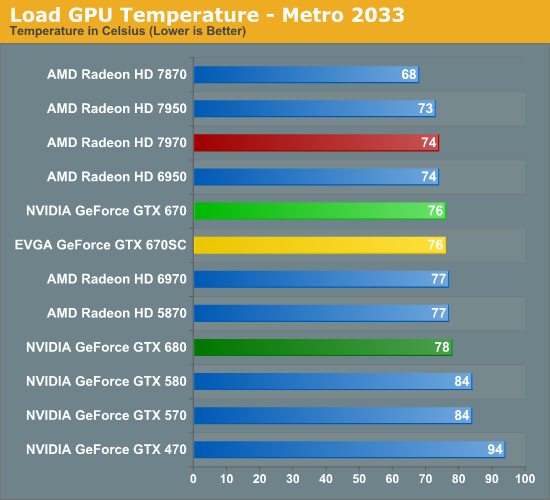
Thanks to the lower power consumption of the GTX 670 temperatures have gone down as well. 76C is still 2C warmer than the Radeon HD 7900 series due to AMD’s more aggressive cooler but it’s 2C cooler than the GTX 680. The thermal threshold for GK104 is 98C, which means there’s still over 20C of thermal headroom to play with here.

OCCT pushes temperatures up some, but not by much thanks to NVIDIA’s power target system. Since the GTX 680 tied the 7970 at 79C here, this means the GTX 670 is 2-3C cooler than both the GTX 680 and the 7970, and 0-1C warmer than the 7950.
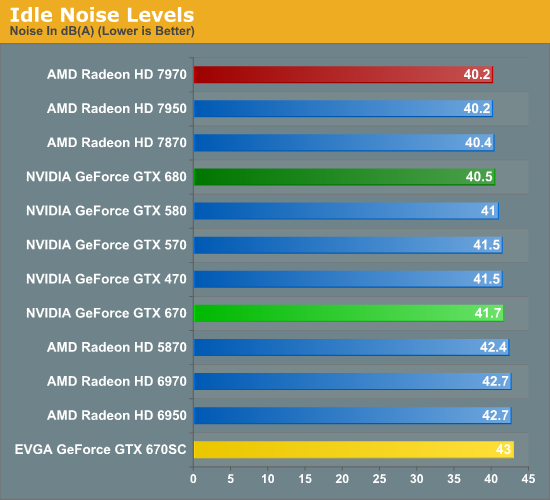
Unfortunately the impressiveness of the GTX 670 begins to wane some here at noise. NVIDIA tells us that the GTX 670 uses the same fan as the GTX 680 but this seems questionable. 41.7dB is not significantly louder than the GTX 680’s 40.5dB, but there’s a definite difference in pitch compared to the GTX 680. The GTX 670 seems to have a low pitch hum/grind to it that GTX 680 didn’t have.
Meanwhile EVGA’s card fares the worst here, at the precipice of falling out of the quiet zone. Since it’s using what’s fundamentally the same fan and cooler as the reference card, the only practical explanation is that EVGA’s smaller diameter fan intake has a negative impact on fan noise.
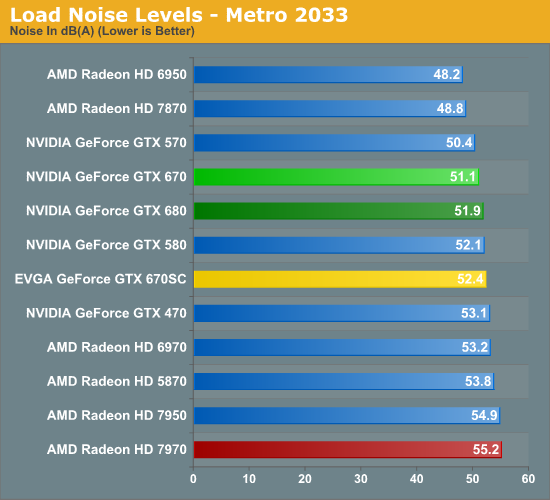
Finally, when looking at load noise we see that the GTX 670 doesn’t fare significantly better or worse than the GTX 680 here. At 0.8dB quieter than the GTX 680 the GTX 670 is a smidge quieter, but it’s nothing that’s particularly appreciable. Perhaps the more important fact is that this is 3.8dB quieter than the 7950 and 4.1dB quieter than the 7970, making the GTX 670 notable quieter than either 7900 series card. In practice the only place the GTX 670 loses is oddly enough to the GTX 570. The GTX 570 was 0.7dB quieter than the GTX 670 despite the former’s much higher power consumption. NVIDIA did let the GTX 570 get hotter than the GTX 670 so it looks like the GTX 670’s fan curve is a bit more aggressive than the GTX 570’s.
As for the EVGA GTX 670 Superclocked we’re seeing the same thing that we saw at idle: it’s just a bit louder than the reference GTX 670. This is in spite of the fact that the GTX 670SC’s fan actually went to the same speed as the reference GTX 670’s fan in this test.
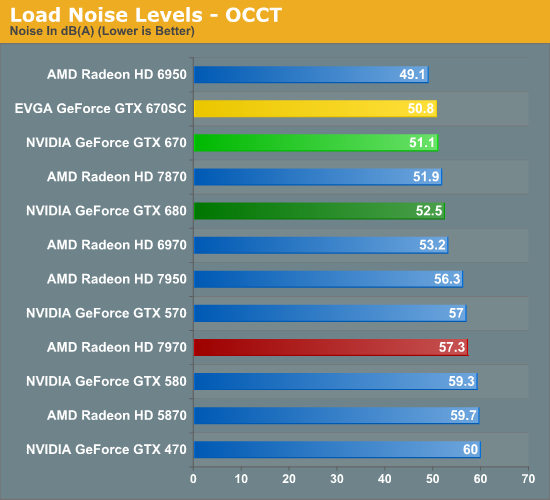
NVIDIA’s power target once more makes itself known here, thanks to which power consumption and thereby heat generation increases very little compared to what we saw under Metro. This widens the gap between the GTX 670 and 7900 series, which is now at 5.2dB and 6.2dB compared to the 7950 and 7970 respectively. Or compared to NVIDIA cards this is 1.4dB quieter than the GTX 680 and nearly 6dB quieter than the unthrottled GTX 570.
Meanwhile there’s something very interesting going on with the GTX 670SC that’s a wider reflection of the GTX 670’s reference fan. The fan speed went up but objective noise (A-weighted) went down. Why? That low-pitch hum we mentioned diminishes with a higher fan speed, and as a result the fan gets quieter once it passes a certain threshold. Subjectively we agree with our sound meter: the GTX 670SC sounds quieter here than it does as the lower fan speed it uses for cooling during Metro. We haven’t experienced anything like this with the GTX 680, which makes us further doubt that the fans are identical between the GTX 680 and GTX 670. Close no doubt, but not the same.
Wrapping things up this entire scenario is very similar to how we saw the launch of the GTX 680 play out. NVIDIA has a strong performing part with less noise and less power consumption than either its 500 series predecessors or AMD’s closest competition. This in turn was a big part of what made the GTX 680 so easy to recommend, as better performance with less noise is exactly the kind of direction we like to see video cards move in.










414 Comments
View All Comments
SlyNine - Saturday, May 12, 2012 - link
lol twist the words any way you want. They will never mean what you want them to mean.The 7970 came out at 570$ and I didn't think it was a bad value. But at the same time its no 2900XT or 5800ultra.
Right now I do feel Nvidia offers a better value. But their are situations, in very high resolutions and on certain games that AMD performs better. Why you cannot see that Nvidia isn't total domination is beyond me.
SlyNine - Saturday, May 12, 2012 - link
lol twist the words any way you want. They will never mean what you want them to mean.The 7970 came out at 570$ and I didn't think it was a *good* value. But at the same time its no 2900XT or 5800ultra.
Right now I do feel Nvidia offers a better value. But their are situations, in very high resolutions and on certain games that AMD performs better. Why you cannot see that Nvidia isn't total domination is beyond me.
CeriseCogburn - Sunday, May 13, 2012 - link
You are correct I did twist them, on purpose.Thanks for actually noticing. Note also I didn't twist like that in my other posts.
ROFL - your welcome.
CeriseCogburn - Sunday, May 13, 2012 - link
PS- even though twisted, my point is still 100% valid, and negates the whole pile from chizow, so it means exactly what I said it meant, but putting two and two together is not your strong suit.You went from 5870, skipped the crappy 6970 generation, die shrink, core jump, because it sucked.
You also passed over the overpriced amd 7970.
chizow whines a lot, but you proved him wrong, and used the method I outlined and said most would do and most owning cards have done, not his stupid retentive one upgrade path only dumb as heck complaint.
CeriseCogburn - Thursday, May 10, 2012 - link
Dude, just sell the 560 and get the 670 - you can stop the cheetos binging and 2x2liter nighttime soda guzzling to make up the difference. Ebay is your friend.eddman - Thursday, May 10, 2012 - link
And what's that supposed to prove? There are many games that use HBAO and FXAA, does it mean they are all botched?Disable them both and run the benchmarks. The difference would be none.
Take unreal 3 for example. Let's say it favors nvidia. If so, then how come bulletstorm runs better on 7970?
CeriseCogburn - Thursday, May 10, 2012 - link
With nVidia card you can just use the upcoming automatic game settings - another gigantic nVidia driver advantage over amd's crap.It's getting far too embarrassing to support amd's crap anymore - there are now numerous absolute fails on amd's part.
It was bad enough when amd didn't pay for PhysX, failed to have openCL in the drivers, had 3 features unchecked in gpu-z that nvidia had covered, failed in DX11 tessellation, was still plagued by the all in wonder corner mouse cursor bug from win98, had no ambient occlusion, cannot support cards going back to the equivalent of nVidia 8 series - but now they're so hammered by so many nVidia advantages beyond all those issues it is embarrassing to the point of humiliating.
No adaptive v-sync now enabled all the way back for nVidia 8 series
No frame rate target
No on the fly power saving adaptive OC.
No 4th monitor for surfing next to the surround eyefinity triples
No driver present taskbar centering for triple monitor (addon amd)
No sneak peek bezel driver support
---
I'll stop because the list is so enormous now - and amd cannot even get working CF drivers going yet for half the games, while nVidia releases with SLI mastery.
NVidia is in a superior position across the board - price, performance, power, drivers, added features, extra features, game day driver releases, and soon a driver optimizer (June ) that they make with their GPU server farms - actually pumping out the work for the gamer - something the embarrassed amd I guess is entirely absent on - while they fire more and more employees - making any sane person clearly see why the drivers that were already suffering are now even worse.
AMD needs to be about half the price of nVidia hardware.
anubis44 - Friday, May 11, 2012 - link
...except that nvidia can't seem to make more than a few dozen at a time.It's pathetic that they're pricing the only two GTX600-series cards to undercut AMD, yet they can't seem to build them. Pretty clever marketing gimmick. You price cards so they undercut the competition, and everybody salivates at the prospect of buying one and decides not to buy the AMD card... except they're not really available. Pretty cheap ploy from one of the most hated companies in the business.
I'd be surprised if half of nvidia's board partners didn't go out of business or jump ship to AMD after this supply fiasco.
CeriseCogburn - Friday, May 11, 2012 - link
This is the 3rd gtx600 series cards, but expecting you to be correct is worse than betting on the broken watch.GTX680 at newegg has outsold the entire amd 7870 and 7850 line up.
Maybe your bean counting should be directed to the corporate pig loser amd ?
At least with nVidia the partners can unload a million backorders when the supply irons out, and 2.5 months after release amd's finally ironed out... it was pathetic until then, so the very thing you spew about partners bailing already happened to amd right ? I mean let's keep your insane spewing consistent across the competition, why not that would be fair..
Congratulations on being so incapable of making a point.
nVidia's partners are counting the backorders and cannot count that high, now they have the even more impressive and winning GTX670 to unload - destroying amd's entire top line.
What were you saying about nVidia partners ? Did your "unconscious" amd inner fanboy totally go bonkers and into insane projection mode ?
It's amd partners that are in trouble now.
LOL
medi01 - Friday, May 11, 2012 - link
Do you get payed for nVidia for posting crap like that or do you work at nVidia?So much idiotic hate towards a company that wasn't cought doing half of the shit, that nVidia did.